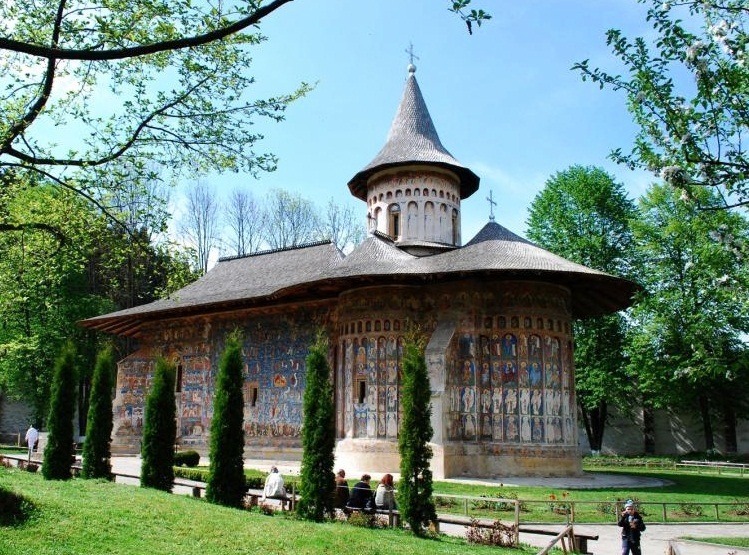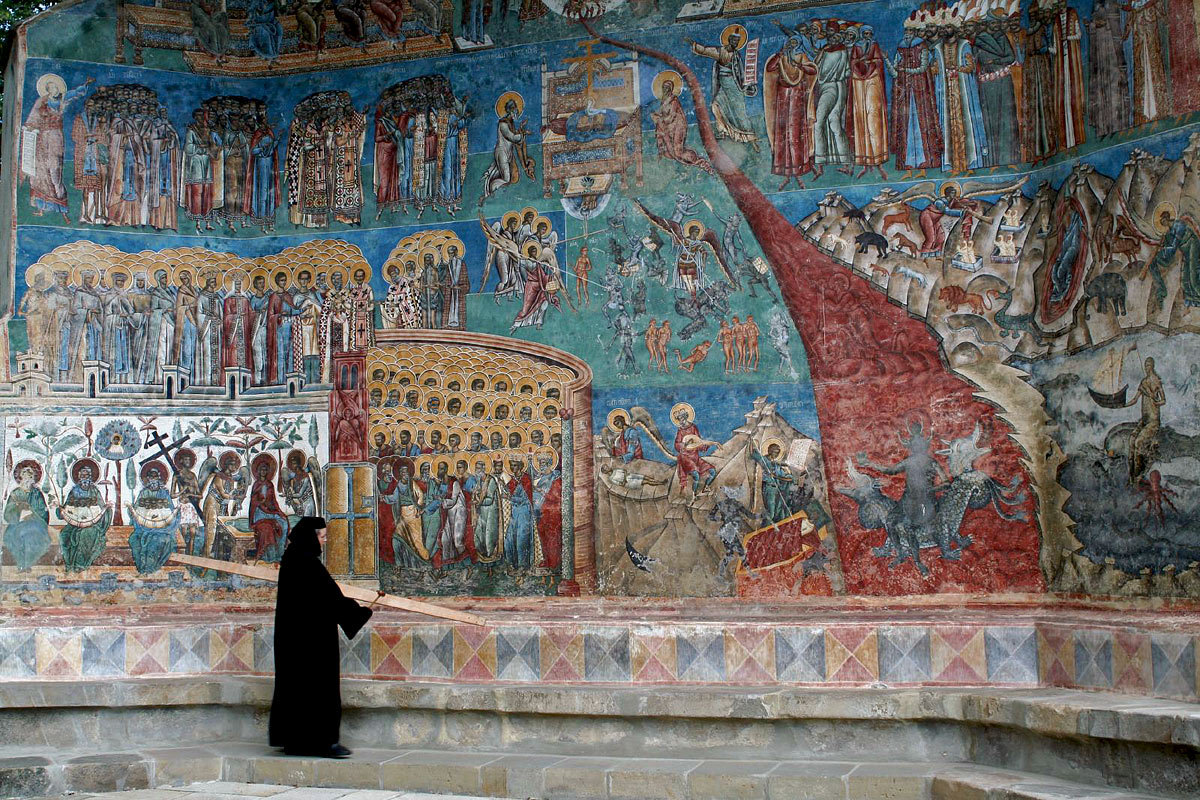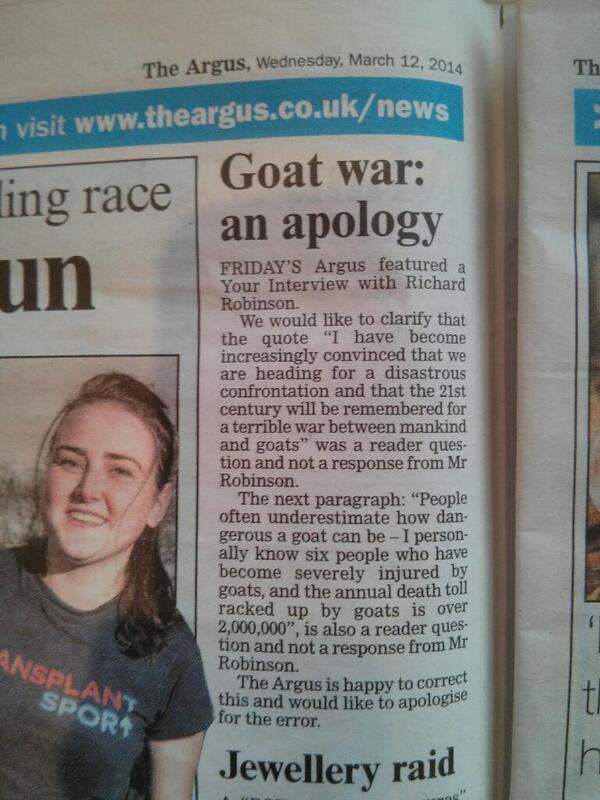In the end, from all my options for Easter, including Mount Athos, Meterora, Kiev, Transylvania, Rome and Clacton-on-Sea, I chose to return to Bucovina and the wonderful painted monasteries, which are for me the most lovely things in Romania, which is saying a very great deal.
Actually, wanting to see what was going on in Ukraine, I went to both Northern and Southern Bucovina. Northern Bucovina has been in Ukraine since the Soviet troops got there in 1944.
For those who don't know, the Bucovina was part of Moldavia that was taken from the Sultan by the Hapsburg Emperor in 1775 to link Galicia (Austrian Poland) to Transylvania. In 1919 the Bucovina was given to Romania but the northern half was seized by Stalin in June 1940. Sometimes people say that this was agreed under the Molotov-Ribbentrop Pact of August 1939 but, in fact, Russia's annexation of Bessarabia (which is now the Republic of Moldova) and the Northern Bucovina had not been agreed with Germany. Romania, allied to Hitler, took it back in 1941. Stalin regained it in 1944.
Most of the Romanians fled or were deported to Siberia after 1944, but I noticed that the villages near the Romanian border have signposts in both the Cyrillic and Latin alphabets. This means that the villagers, or some of them, speak Romanian, are Romanians.
The name Bucovina means land of the beech trees and they are everywhere on the rolling hillsides.
The capital of the Bucovina under Austria and until 1940 was Cernauti. This is its Romanian name, it's Czernowitz in German or Cernivtisi in Ukrainian. It was an enormous pleasure to return for my second visit. Since my first visit I have had the chance to hear a lecture on life in Cernauti before 1914 by an Australian historian - Bucovina was Austria's equivalent of the Wild West, an unsettled place where fortunes could be made and lost and where people of all ethnic groups settled, Jews being the largest group. People of different ethnic groups never live side by side in complete amity but the citizens of Cernauti seem to have got by without too many great problems. The end of the Habsburg monarchy and war was to change this.
For decades I only travelled in post-Communist Europe and I still find it depressing to go to Western Europe. All that shininess and affluence make my heart sink. But I went to Western Europe for the monuments and to places like Burma and Mozambique to see the world until I realised that it is only Eastern Europe that I really love - where people are human and normal. I especially love Ukraine and dear Cernauti, which are like Eastern Europe used to be in the late 1990s.
Last time I was there, in 2007, I thought it was much like Satu Mare or Baie Mare or many other Austro-Hungarian towns but it is more charming than they are. The buildings are wonderful pastel shades in the early evening sunshine and there is an indescribable calm here which is only found in countries which are not powerful or rich or in the EU. What a joy it is to leave the EU, although the people of Western Ukraine would probably love to join it.
We arrived on Good Friday, and the mauve-pink Cathedral, once Romanian Orthodox and now one of the three kinds of Ukrainian Orthodox, was thronged with worshippers. I spent ten minutes there but my friend who had driven me to Cernauti stood outside waiting for me and so I went out again by that same door wherein I went, sorry that I should miss the Burial of the Lord ceremony, when a coffin is taken in procession around the church and nearby streets.
We walked around the lovely town bathed in evening sunlight and the sense of pleasing melancholy that you get in provincial towns towards the end of day, especially in obscure countries.I had looked forward to chatting to locals about revolution and war but there was no-one to talk to. We did see an impromptu shrine to the heroes killed at the Maidan in Kiev, two of whom were local men or boys. Then we looked through the empty town for somewhere to eat and ended up eating a wonderful halibut at our hotel, the Hotel Bukovyna and salmon blinis. Far too big a feast for Good Friday, I know.
We spent Saturday morning mooching around Cernauti and then went back to the future in Romania where we stumbled on the wonderful little painted church at Padrauti. Rain-swept and chilly it was easy to imagine Stephen the Great winning a battle against the Muslims in this remote barbaric spot.
Then Suceava and though the town was closed for Easter we ate a really wonderful tochitura in a brasserie called Centru Vechi. I realise that huge portions are the Bucovinan idea of hospitality. Even I, even I, left half my food.
I found the war memorial in Suceava saddening. Romanians should have avoided war in 1877 and 1916. Had Romanian borders not been enlarged in 1919 Romania might have kept out of Second World War and avoided Communism. On reflection, though, this last idea is unconvincing because even had Romania remained neutral in the First World War Bessarabia (now Moldova) would still have dropped into her arms after the Russian revolution and therefore would have been taken back at some point by Stalin. It would however have been in Romania's interests to stay out of the Great War and in the interests of her allies too. Norman Stone said that the entry of Romania on the Allied side in 1916 delayed the Allies' victory by a year.
In Suceava I read about the fifty thousand Jews rounded up into the Cernauti ghetto by Romanians by order of Antonescu in 1941 and later killed. I had forgotten this until someone reminded me. attended the Catholic Mass and then the Orthodox, which moves me much more deeply. The latter ended at 3.30 and then I found Lidia Rusu, with whom I was staying, who drove me back - it took over an hour - to Vama.

Actually, wanting to see what was going on in Ukraine, I went to both Northern and Southern Bucovina. Northern Bucovina has been in Ukraine since the Soviet troops got there in 1944.
For those who don't know, the Bucovina was part of Moldavia that was taken from the Sultan by the Hapsburg Emperor in 1775 to link Galicia (Austrian Poland) to Transylvania. In 1919 the Bucovina was given to Romania but the northern half was seized by Stalin in June 1940. Sometimes people say that this was agreed under the Molotov-Ribbentrop Pact of August 1939 but, in fact, Russia's annexation of Bessarabia (which is now the Republic of Moldova) and the Northern Bucovina had not been agreed with Germany. Romania, allied to Hitler, took it back in 1941. Stalin regained it in 1944.
Most of the Romanians fled or were deported to Siberia after 1944, but I noticed that the villages near the Romanian border have signposts in both the Cyrillic and Latin alphabets. This means that the villagers, or some of them, speak Romanian, are Romanians.
The name Bucovina means land of the beech trees and they are everywhere on the rolling hillsides.
The capital of the Bucovina under Austria and until 1940 was Cernauti. This is its Romanian name, it's Czernowitz in German or Cernivtisi in Ukrainian. It was an enormous pleasure to return for my second visit. Since my first visit I have had the chance to hear a lecture on life in Cernauti before 1914 by an Australian historian - Bucovina was Austria's equivalent of the Wild West, an unsettled place where fortunes could be made and lost and where people of all ethnic groups settled, Jews being the largest group. People of different ethnic groups never live side by side in complete amity but the citizens of Cernauti seem to have got by without too many great problems. The end of the Habsburg monarchy and war was to change this.
For decades I only travelled in post-Communist Europe and I still find it depressing to go to Western Europe. All that shininess and affluence make my heart sink. But I went to Western Europe for the monuments and to places like Burma and Mozambique to see the world until I realised that it is only Eastern Europe that I really love - where people are human and normal. I especially love Ukraine and dear Cernauti, which are like Eastern Europe used to be in the late 1990s.
Last time I was there, in 2007, I thought it was much like Satu Mare or Baie Mare or many other Austro-Hungarian towns but it is more charming than they are. The buildings are wonderful pastel shades in the early evening sunshine and there is an indescribable calm here which is only found in countries which are not powerful or rich or in the EU. What a joy it is to leave the EU, although the people of Western Ukraine would probably love to join it.
We arrived on Good Friday, and the mauve-pink Cathedral, once Romanian Orthodox and now one of the three kinds of Ukrainian Orthodox, was thronged with worshippers. I spent ten minutes there but my friend who had driven me to Cernauti stood outside waiting for me and so I went out again by that same door wherein I went, sorry that I should miss the Burial of the Lord ceremony, when a coffin is taken in procession around the church and nearby streets.
We walked around the lovely town bathed in evening sunlight and the sense of pleasing melancholy that you get in provincial towns towards the end of day, especially in obscure countries.I had looked forward to chatting to locals about revolution and war but there was no-one to talk to. We did see an impromptu shrine to the heroes killed at the Maidan in Kiev, two of whom were local men or boys. Then we looked through the empty town for somewhere to eat and ended up eating a wonderful halibut at our hotel, the Hotel Bukovyna and salmon blinis. Far too big a feast for Good Friday, I know.
We spent Saturday morning mooching around Cernauti and then went back to the future in Romania where we stumbled on the wonderful little painted church at Padrauti. Rain-swept and chilly it was easy to imagine Stephen the Great winning a battle against the Muslims in this remote barbaric spot.
.jpg) |
| Padrauti |
Then Suceava and though the town was closed for Easter we ate a really wonderful tochitura in a brasserie called Centru Vechi. I realise that huge portions are the Bucovinan idea of hospitality. Even I, even I, left half my food.
I found the war memorial in Suceava saddening. Romanians should have avoided war in 1877 and 1916. Had Romanian borders not been enlarged in 1919 Romania might have kept out of Second World War and avoided Communism. On reflection, though, this last idea is unconvincing because even had Romania remained neutral in the First World War Bessarabia (now Moldova) would still have dropped into her arms after the Russian revolution and therefore would have been taken back at some point by Stalin. It would however have been in Romania's interests to stay out of the Great War and in the interests of her allies too. Norman Stone said that the entry of Romania on the Allied side in 1916 delayed the Allies' victory by a year.
In Suceava I read about the fifty thousand Jews rounded up into the Cernauti ghetto by Romanians by order of Antonescu in 1941 and later killed. I had forgotten this until someone reminded me. attended the Catholic Mass and then the Orthodox, which moves me much more deeply. The latter ended at 3.30 and then I found Lidia Rusu, with whom I was staying, who drove me back - it took over an hour - to Vama.
Sunday lunch was cooked by Lidia Rusu's husband who is the best cook I have encountered in fifteen years in Romania. I knew an equally good Hungarian cook in Transylvania in the early 1990s but she moved to Hungary and, alas, she is dead. In any case it is not possible to compare Hungarian food with Romanian food. The meal was wonderful and unfortunately I found I did not a strong enough personality to resist the home-made tzuica.
Vespers at the village church (a pretty one built in 1990 but to the same design as churches had long ago). Then my second visit to the Vama Egg Museum, now much bigger than in 2002 and a thriving business with painted eggs from around the world. I saw an ostrich's egg, which in Switzerland had been cut open and made into the replica of a church complete with congregation. But the painted eggs from the region were the point of the exhibition. Painting eggs (emptied of their contents first) are the Bucovinan tradition.
Monday began with Mass on a crisp sunny morning at the beautiful painted monastery at Moldovita. Then lovely Voronet and Humor. For readers who do not know Romania these and several other monasteries have no architectural interest but are famous for their wall paintings inside and outside which form wonderful galleries of mediaeval sacred painting. Romanians come to see them for their great beauty and also for the purpose for which they were made as an aid to prayer. Bucovina is becoming more developed these days and starting to get a little commercialised but there is still a sense of holiness here and still a traditional rural way of life, though that is changing very much. Now Romanians go and find work in Eastern Europe and Romanian agriculture is, for reasons I do not fully understand, in big trouble.
Monday began with Mass on a crisp sunny morning at the beautiful painted monastery at Moldovita. Then lovely Voronet and Humor. For readers who do not know Romania these and several other monasteries have no architectural interest but are famous for their wall paintings inside and outside which form wonderful galleries of mediaeval sacred painting. Romanians come to see them for their great beauty and also for the purpose for which they were made as an aid to prayer. Bucovina is becoming more developed these days and starting to get a little commercialised but there is still a sense of holiness here and still a traditional rural way of life, though that is changing very much. Now Romanians go and find work in Eastern Europe and Romanian agriculture is, for reasons I do not fully understand, in big trouble.
 |
Voroneţ Monastery
|






